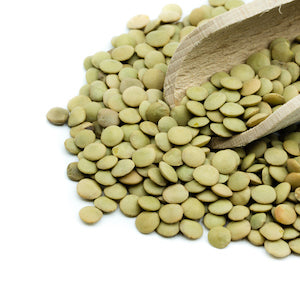LENTILS, GREEN, ORGANIC 25 LB
LENTILS, GREEN, ORGANIC 25 LB
Sold Out
Couldn't load pickup availability
Item Description

Lentils: A Simple Guide
A humble legume with a high nutritional value, lentils make a hearty rnmeal, and they really are quite tasty! Lentils are rich in the minerals rnphosphorus, iron, and magnesium, which promote healthy cells, healthy rnsleep, blood, bones, and teeth. But without proper preparation, many or most of these minerals are bound up in an antinutrient called phytate, and carried out of your body before it can even use them.
I’m going to show you how to properly prepare lentils so they can rnbest nourish your body. We’ll also talk about the difference between rnFrench lentils, red lentils, and ordinary green lentils, and which rnvarieties are best suited for which purposes. The pictures below will give you a feel for how each variety cooks up.
Soaking Lentils
You may have heard that lentils don’t need to be soaked before rncooking, and that’s true from a culinary perspective. But from a health perspective, there’s an important reason you should be soaking your lentils.
All beans are high in the antinutrient phytic acid, or phytate, whichrn grabs on to the minerals in your meal and carries them out before your rnbody is able to use them. Soaking lentils effectively neutralizes the rnphytic acid so that your body can absorb the minerals you’re rneating. That’s why traditional societies always gave their lentils a rnthorough soaking before preparing them. Think of ethnic foods like Indian Dosas and Dal.
Obviously, one of the main reasons we eat is to nourish our bodies rnwith the vitamins and minerals we need to be healthy. When you’re tryingrn to prevent or reverse tooth decay, or improve your health in some otherrn way, it’s important to get all the minerals you can. Soaking your lentils (and all of your beans) will enable your body to better absorb the minerals in the foods you eat.
Soak lentils for about 6 hours or overnight in warm water with a couple tablespoons of lemon juice. (The soaking liquid needs to be slightly acidic to neutralize phytic acid and free up minerals for your body.)

French Lentils
The attribute that gives French lentils an edge is that they hold rntheir shape and stay more firm than ordinary green lentils, and rnconsiderably more so than red lentils. This makes them perfectly suited rnfor salads. Use them as a side dish with vegetables, in a light soup, or even as a main course.
To prepare French Lentils, first cover them in warm water with a rnlittle lemon juice or apple cider vinegar and soak for 6 hours or rnovernight. Drain the soaking water and add one and a half times again rnthe amount of fresh water or broth as the amount of lentils you’re rnusing. Simmer for about 20 – 25 minutes.
French Lentils are rich in antioxidants and phytochemicals similar torn the ones in blueberries and black grapes. (I’ve even noticed, when I rndrain the soaking water, that it has become the color of wine.) They are high in minerals too, particularly iron and magnesium, and if you soak rnthem before cooking, you’ll benefit much more from these minerals.
French Lentils are grown using the same kind of lentil as Puy lentils. However, since they are grown in the U.S., Canada, or Italy, as opposed to the Puy region in the nation of France, they are never to be called Puy lentils. They can be substituted in any recipe that calls for Puy lentils, and they are much less expensive.

Red Lentils
Red lentils can range in color from gold, orange, and actual red. With their sweet and nutty flavor, they are arguably the best-tasting of all the lentil varieties, but that’s just my opinion! Red lentils are rnso small that they don’t require much cooking time at all and can be rnready in as little as 15 minutes if you’ve soaked them first. They are infamous for becoming pretty much mush – though very tasty mush – when cooked all the way through, so they are best used in curries or for thickening soups.
Before you soak them, rinse your red lentils in running water until rnthe milky, dusty residue comes off and the water runs clear. Then cover rnthem in warm water with a little lemon juice or apple cider vinegar and rnsoak for 6 hours or overnight. Drain the soaking water and add one and arn half times again the amount of fresh water or broth as the amount of rnlentils you’re using. Simmer for about 15 – 20 minutes.

Green Lentils
This is the common lentil; the kind most folks think of when they rnhear the word. Green lentils can be a brownish green or a khaki brown. They have a mild, earthy flavor, hold their shape almost as well as rnFrench lentils, and are a great addition to soups and stews.
Prepare green lentils the same way you’d make French lentils. The rnonly difference is green lentils’ cooking time is slightly shorter, about 15 – 20 minutes.
If you look closely at the Green Lentil Soup picture, you’ll see rnpointy little sprouts coming out of a couple of the lentils. Lentils rnsprout fast! These were only soaked overnight, and by morning, most of rnthem had sprouted.
Fun Fact: The Black Beluga Lentil
People often find foreign seeds in our organic wheat, and the black beluga lentil is one that is frequently discovered. It’s shaped like a rntiny green lentil, but it’s a dark brown or black color. Follow this link to learn why it’s common (and even natural) for there to be seeds like this in organic wheat.
Share


